2010年高考英语动词的-ing形式
- 格式:doc
- 大小:168.50 KB
- 文档页数:12
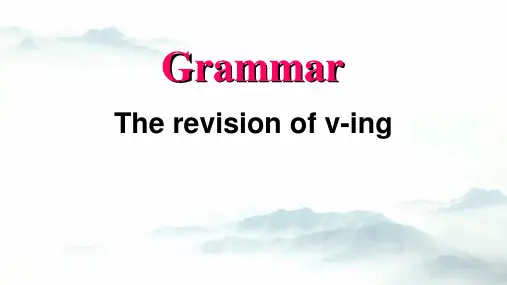
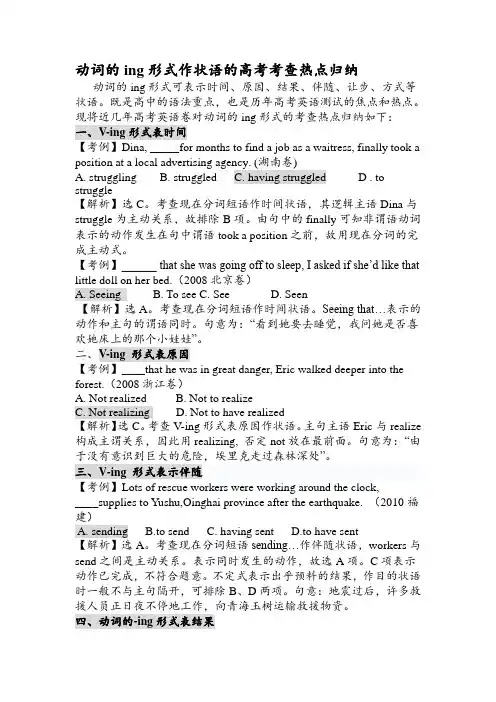
动词的ing形式作状语的高考考查热点归纳动词的ing形式可表示时间、原因、结果、伴随、让步、方式等状语。
既是高中的语法重点,也是历年高考英语测试的焦点和热点。
现将近几年高考英语卷对动词的ing形式的考查热点归纳如下:一、V-ing形式表时间【考例】Dina, _____for months to find a job as a waitress, finally took aposition at a local advertising agency. (湖南卷)A. strugglingB. struggledC. having struggled D . to struggle【解析】选C。
考查现在分词短语作时间状语,其逻辑主语Dina与struggle为主动关系,故排除B项。
由句中的finally可知非谓语动词表示的动作发生在句中谓语took a position之前,故用现在分词的完成主动式。
【考例】______ that she was going off to sleep, I asked if she’d like thatlittle doll on her bed.(2008北京卷)A. SeeingB. To seeC. SeeD. Seen【解析】选A。
考查现在分词短语作时间状语。
Seeing that…表示的动作和主句的谓语同时。
句意为:“看到她要去睡觉,我问她是否喜欢她床上的那个小娃娃”。
二、V-ing 形式表原因【考例】____that he was in great danger, Eric walked deeper into theforest.(2008浙江卷)A. Not realizedB. Not to realizeC. Not realizingD. Not to have realized【解析】选C。
考查V-ing形式表原因作状语。
主句主语Eric与realize 构成主谓关系,因此用realizing, 否定not放在最前面。
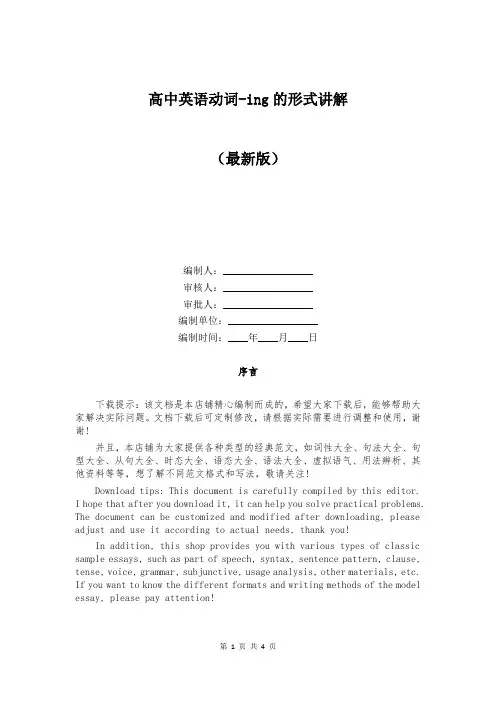
高中英语动词-ing的形式讲解(最新版)编制人:__________________审核人:__________________审批人:__________________编制单位:__________________编制时间:____年____月____日序言下载提示:该文档是本店铺精心编制而成的,希望大家下载后,能够帮助大家解决实际问题。
文档下载后可定制修改,请根据实际需要进行调整和使用,谢谢!并且,本店铺为大家提供各种类型的经典范文,如词性大全、句法大全、句型大全、从句大全、时态大全、语态大全、语法大全、虚拟语气、用法辨析、其他资料等等,想了解不同范文格式和写法,敬请关注!Download tips: This document is carefully compiled by this editor.I hope that after you download it, it can help you solve practical problems. The document can be customized and modified after downloading, please adjust and use it according to actual needs, thank you!In addition, this shop provides you with various types of classic sample essays, such as part of speech, syntax, sentence pattern, clause, tense, voice, grammar, subjunctive, usage analysis, other materials, etc. If you want to know the different formats and writing methods of the model essay, please pay attention!高中英语动词-ing的形式讲解动词的-ing形式包括传统语法的“动名词”(gerund)和“现在分词”(present participle)两个部分。

非谓语动词之-ing形式非谓语动词在英语中用途很广,在考试中是重点,在学习中是难点,但是它还是有很多规律可以遵循,今天我希望经过我的整理和归纳,让非谓语动词简单起来。
非谓语动词的三种形式:-ing形式to do(不定式) done(过去分词)非谓语动词之ing形式ing形式的使用条件:1.当句中有谓语动词并且没有连词and, but, so,when,because等连接时,再出现一个动词,这个动词就要用非谓语动词形式。
2.确定是非谓语动词之后,还要看是否表示主动,如果是主动不表示将来或目的,就用-ing形式。
-ing 在句中充当主语,表语,宾语,定语,补语和状语,绝对不能充当谓语。
Eg. Swimming is good to our health.(主语)游泳对我们的健康有好处。
My hobby is swimming.(表语)我的爱好是游泳。
He likes swimming.(宾语)他喜欢游泳。
He saw the old lady fishing near the river.(宾补)他看见这位老太太正在河边钓鱼。
The old people swimming in the pool are very happy.(定语)正在游泳池里游泳的老人们是很快乐的。
Swimming in the river, they are very happy.(状语)一.-ing 的基本用法-ing充当主语当用动词的形式作主语时,大多数情况都用动词的-ing 形式作主语。
还有少数表示将来或目的,应该用to do 作主语。
另外在It is adj./n. +for sb to do sth. 这个句型中,经常用不定式to do 作主语。
温馨提示:It is no use/ useless/no good/not good/fun/ a waste of time +doing.“做...是没有用的/没有好处的/有趣的/浪费时间的这个句型中经常用doing作主语。
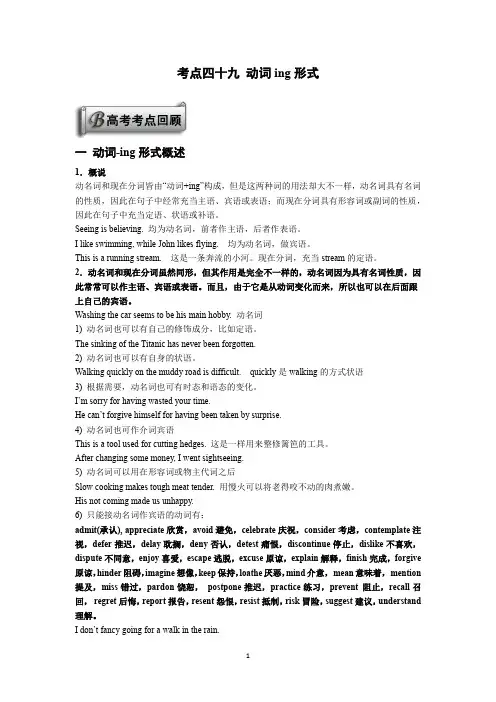
考点四十九动词ing形式一动词-ing形式概述1.概说动名词和现在分词皆由“动词+ing”构成,但是这两种词的用法却大不一样,动名词具有名词的性质,因此在句子中经常充当主语、宾语或表语;而现在分词具有形容词或副词的性质,因此在句子中充当定语、状语或补语。
Seeing is believing. 均为动名词,前者作主语,后者作表语。
I like swimming, while John likes flying. 均为动名词,做宾语。
This is a running stream. 这是一条奔流的小河。
现在分词,充当stream的定语。
2.动名词和现在分词虽然同形,但其作用是完全不一样的,动名词因为具有名词性质,因此常常可以作主语、宾语或表语。
而且,由于它是从动词变化而来,所以也可以在后面跟上自己的宾语。
Washing the car seems to be his main hobby. 动名词1) 动名词也可以有自己的修饰成分,比如定语。
The sinking of the Titanic has never been forgotten.2) 动名词也可以有自身的状语。
Walking quickly on the muddy road is difficult. quickly是walking的方式状语3) 根据需要,动名词也可有时态和语态的变化。
I’m sorry for having wasted your time.He can’t forgive himself for having been taken by surprise.4) 动名词也可作介词宾语This is a tool used for cutting hedges. 这是一样用来整修篱笆的工具。
After changing some money, I went sightseeing.5) 动名词可以用在形容词或物主代词之后Slow cooking makes tough meat tender. 用慢火可以将老得咬不动的肉煮嫩。
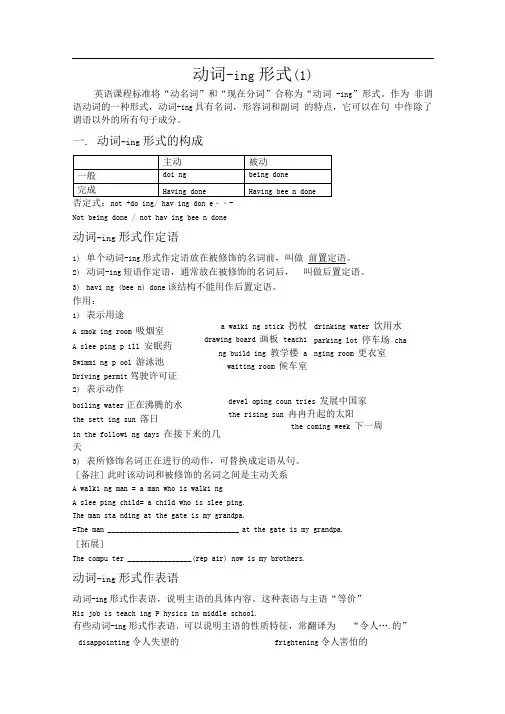
动词-ing 形式(1)英语课程标准将“动名词”和“现在分词”合称为“动词 -ing ”形式。
作为 非谓语动词的一种形式,动词-ing 具有名词,形容词和副词 的特点,它可以在句 中作除了谓语以外的所有句子成分。
一. 动词-ing 形式的构成否定式:not +do ing/ hav ing don e ・・-Not being done / not hav ing bee n done动词-ing 形式作定语1)单个动词-ing 形式作定语放在被修饰的名词前,叫做 前置定语。
2) 动词-ing 短语作定语,通常放在被修饰的名词后, 3) havi ng (bee n) done 该结构不能用作后置定语。
作用:1) 表示用途A smok ing room 吸烟室A slee ping p ill 安眠药Swimmi ng p ool 游泳池Driving permit 驾驶许可证2) 表示动作boiling water 正在沸腾的水 the sett ing sun 落日in the followi ng days 在接下来的几天3) 表所修饰名词正在进行的动作,可替换成定语从句。
[备注]此时该动词和被修饰的名词之间是主动关系A walki ng man = a man who is walki ngA slee ping child= a child who is slee ping.The man sta nding at the gate is my grandpa.=The man _________________________________ at the gate is my grandpa.[拓展]The compu ter ________________ (rep air) now is my brothers.动词-ing 形式作表语动词-ing 形式作表语,说明主语的具体内容。
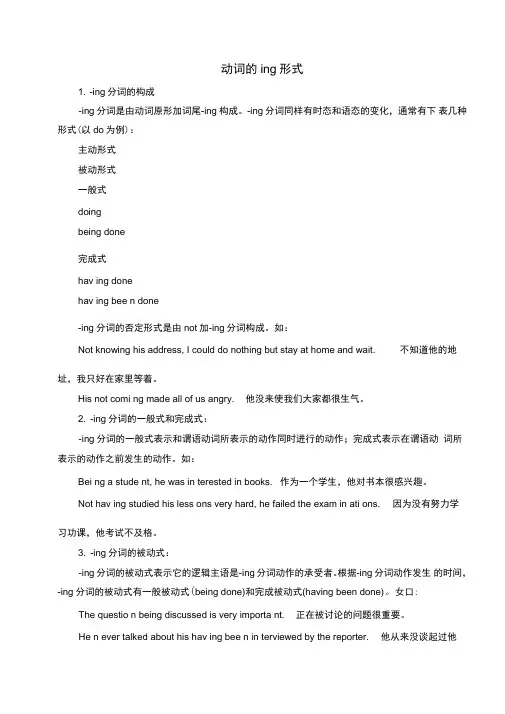
动词的ing形式1. -ing分词的构成-ing分词是由动词原形加词尾-ing构成。
-ing分词同样有时态和语态的变化,通常有下表几种形式(以do为例):主动形式被动形式一般式doingbeing done完成式hav ing donehav ing bee n done-ing分词的否定形式是由not加-ing分词构成。
如:Not knowing his address, I could do nothing but stay at home and wait. 不知道他的地址,我只好在家里等着。
His not comi ng made all of us angry. 他没来使我们大家都很生气。
2. -ing分词的一般式和完成式:-ing分词的一般式表示和谓语动词所表示的动作同时进行的动作;完成式表示在谓语动词所表示的动作之前发生的动作。
如:Bei ng a stude nt, he was in terested in books. 作为一个学生,他对书本很感兴趣。
Not hav ing studied his less ons very hard, he failed the exam in ati ons. 因为没有努力学习功课,他考试不及格。
3. -ing分词的被动式:-ing分词的被动式表示它的逻辑主语是-ing分词动作的承受者。
根据-ing分词动作发生的时间,-ing分词的被动式有一般被动式(being done)和完成被动式(having been done)。
女口: The questio n being discussed is very importa nt. 正在被讨论的问题很重要。
He n ever talked about his hav ing bee n in terviewed by the reporter. 他从来没谈起过他被记者采访的事情。
Havi ng bee n criticized by the teacher, he gave up smok ing. 被老师批评以后,他把烟戒了。
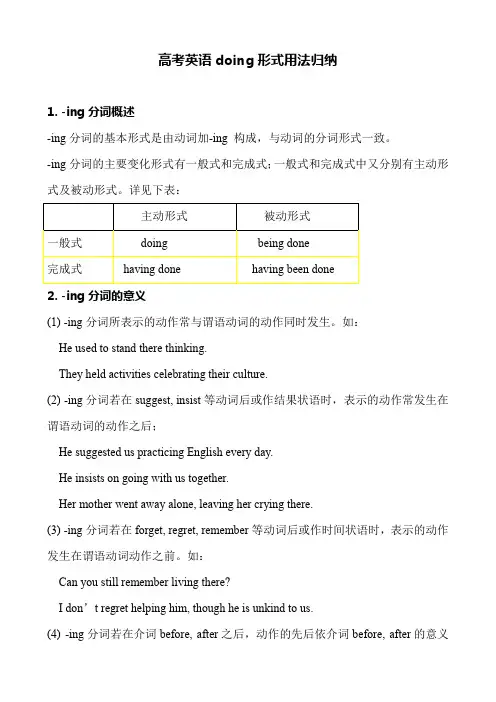
高考英语doing形式用法归纳1. -ing分词概述-ing分词的基本形式是由动词加-ing 构成,与动词的分词形式一致。
-ing分词的主要变化形式有一般式和完成式;一般式和完成式中又分别有主动形式及被动形式。
详见下表:(3) -ing分词若在forget, regret, remember等动词后或作时间状语时,表示的动作发生在谓语动词动作之前。
如:Can you still remember living there?I don’t regret helping him, though he is unkind to us.(4) -ing分词若在介词before, after之后,动作的先后依介词before, after的意义而定。
如:I often read some newspaper before getting to sleep.(5) -ing分词表泛指意义的动作或状态时,没有时间意义。
如:Keeping on doing morning exercises is a good habit.(6) -ing分词的完成式表示所发生的动作在谓语动词的动作之前。
如:Not having received her answer, he decided to write to her again.(7) -ing分词的主动形式,表明逻辑主语所发出的动作;-ing分词的被动形式表明逻辑主语是动作的承受者。
如:Seeing from the top of the mountain, you will find the town very beautiful.Seen from the top of the mountain, the town looks beautiful.(8) -ing分词的否定式是在-ing分词前面加否定词not。
如:Not knowing what to do, he went to ask the teacher for help.Not having made it clear, he went to ask the teacher about it again.3. -ing分词的句法功能-ing分词具有动词的一些特征,可带自己的宾语或状语,从而一起构成动词—ing 形式的短语。
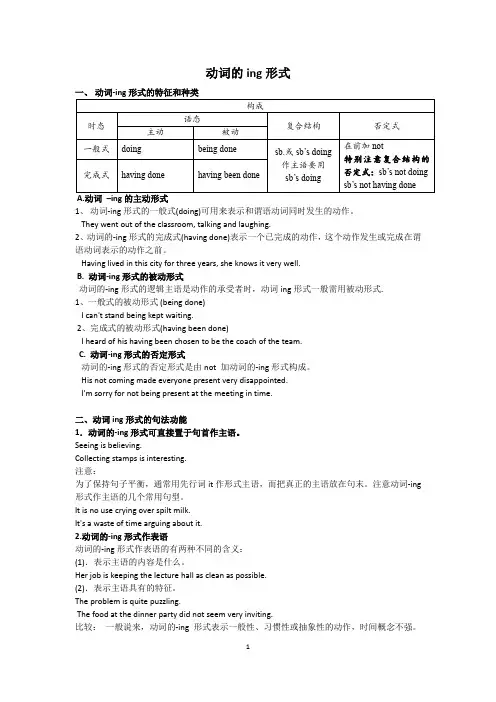
动词的ing形式1、动词-ing形式的一般式(doing)可用来表示和谓语动词同时发生的动作。
They went out of the classroom, talking and laughing.2、动词的-ing形式的完成式(having done)表示一个已完成的动作,这个动作发生或完成在谓语动词表示的动作之前。
Having lived in this city for three years, she knows it very well.B. 动词-ing形式的被动形式动词的-ing形式的逻辑主语是动作的承受者时,动词ing形式一般需用被动形式.1、一般式的被动形式 (being done)I can't stand being kept waiting.2、完成式的被动形式(having been done)I heard of his having been chosen to be the coach of the team.C. 动词-ing形式的否定形式动词的-ing形式的否定形式是由not 加动词的-ing形式构成。
His not coming made everyone present very disappointed.I'm sorry for not being present at the meeting in time.二、动词ing形式的句法功能1.动词的-ing形式可直接置于句首作主语。
Seeing is believing.Collecting stamps is interesting.注意:为了保持句子平衡,通常用先行词it作形式主语,而把真正的主语放在句末。
注意动词-ing 形式作主语的几个常用句型。
It is no use crying over spilt milk.It's a waste of time arguing about it.2.动词的-ing形式作表语动词的-ing形式作表语的有两种不同的含义:(1).表示主语的内容是什么。
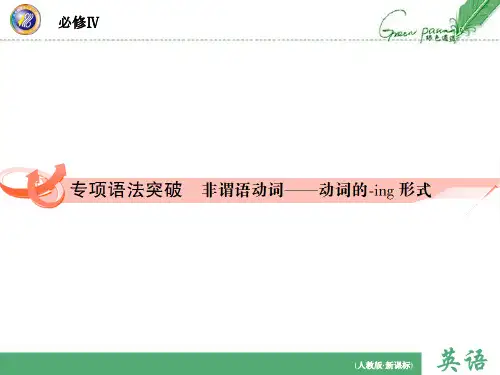
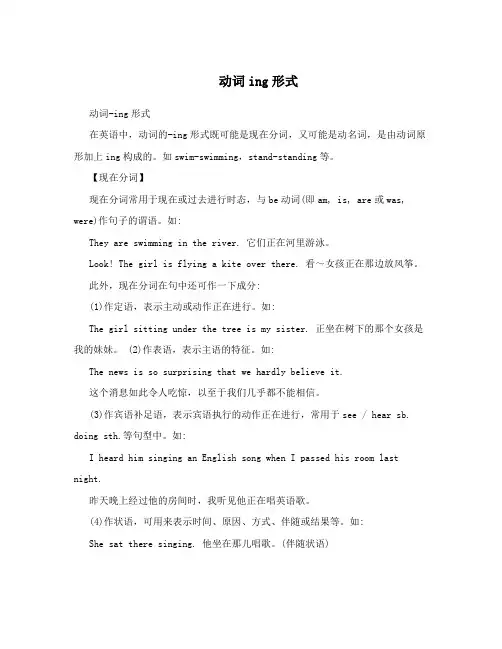
动词ing形式动词-ing形式在英语中,动词的-ing形式既可能是现在分词,又可能是动名词,是由动词原形加上ing构成的。
如swim-swimming,stand-standing等。
【现在分词】现在分词常用于现在或过去进行时态,与be动词(即am, is, are或was, were)作句子的谓语。
如:They are swimming in the river. 它们正在河里游泳。
Look! The girl is flying a kite over there. 看~女孩正在那边放风筝。
此外,现在分词在句中还可作一下成分:(1)作定语,表示主动或动作正在进行。
如:The girl sitting under the tree is my sister. 正坐在树下的那个女孩是我的妹妹。
(2)作表语,表示主语的特征。
如:The news is so surprising that we hardly believe it.这个消息如此令人吃惊,以至于我们几乎都不能相信。
(3)作宾语补足语,表示宾语执行的动作正在进行,常用于see / hear sb. doing sth.等句型中。
如:I heard him singing an English song when I passed his room last night.昨天晚上经过他的房间时,我听见他正在唱英语歌。
(4)作状语,可用来表示时间、原因、方式、伴随或结果等。
如:She sat there singing. 他坐在那儿唱歌。
(伴随状语)Being so poor, he couldn’t get to school. 因为太穷了,所以他不能去上学。
(原因状语) 【动名词】动名词是一种非限定动词,它兼有动词或名词的特征。
在句中可作主语、表语、定语等,常见用法如下:(1)作主语。
如:Reading in the sun is bad for our eyes. 在太阳底下看书对我们的眼睛不好。
英语语法学习:英语中六种动词的-ing形式知识点汇编动词-ing形式的时态和语态动词-ing形式有主动、被动两种形式,也有一般式和完成式。
说明:1. 动词-ing形式的一般式表示的动作与主句谓语同时发生或稍后发生。
2. 动词-ing形式的完成式表示的动作发生在主句谓语动词之前。
3. 动词-ing形式的被动形式being done, having been done表示正在被发生或已经被发生。
4. 动词-ing形式的否定形式:not doing/not having done/not being done/not having been done。
动词-ing形式的句法功能动词-ing形式可用作主语、宾语、表语、定语、宾语补足语或状语。
1. 动词-ing形式作主语:动词-ing形式作主语表示一种概念、习惯或经验。
为了平衡句子结构,可用it作形式主语,而把真正的主语动词-ing形式放到后面。
常见句型有:It be no use doing … 做……无用;It be no good/pleasure/fun doing … 做……无好处/乐趣;It bea waste of time/money doing … 做……浪费时间/金钱。
2. 动词-ing形式作宾语:(1) 介词后可跟动词-ing形式作宾语。
(2) 动词或短语动词avoid, mind, miss, enjoy, keep, finish, suggest, propose, recommend, consider, risk, look forward to, get down to, lead to, set about, feel like, put off等后接动词-ing形式作宾语。
注意:有些动词后接动词-ing形式作宾语和不定式作宾语有区别:remember to do sth. 记住要做某事remember doing sth. 记得做过某事regret to do sth. 遗憾要做某事regret doing sth. 后悔做过某事stop to do sth. 停下来去做另一件事stop doing sth. 停止正在做的事mean to do sth. 打算做某事mean doing sth. 意味着做某事can’t help (to) do sth. 不能帮助做某事can’t help doing sth. 禁不住做某事3. 动词-ing形式作表语:一是用来说明主语的内容,主语和表语可以互换位置;二是表示主语所具有的特征。
非谓语动词——动词-ing形式恒口高中潘振斌2012、1第一讲:v.-ing的形式:动词的-ing形式是一种非谓语动词。
-ing形式仍保留有动词的特征,可以带有其所需要的宾语或状语而构成-ing短语。
它既具有动词时态和语态的特征,又具有名词、形容词和副词的特征,它可以在句中作主语、表语、定语、宾语、状语、宾语补足语、主语补足语等。
-ing有一般式和完成式。
及物动词的-ing还有主动语态和被动语态,而不及物动词的-ing则没有被动语态。
现在以及物动词write为例,将其-ing各种形式列表如下:动词-ing形式的时态、语态主动语态被动语态一般式writing being written完成式having written having been written否定式not writing1.v.-ing形式的一般式V.-ing形式的一般式的构成,表示动作发生在谓语动词动作的同时、之前或之后。
可用来泛指动作,没有时间的区分。
Seeking after knowledge is human nature.求知是人的本性。
can widen one’s outlook.出国旅游会扩大人们的视野。
is bad for your teeth.吃太多的巧克力对你的牙齿有害。
My favourite sport is .我最喜欢的运动是打乒乓球可表示行为与主要动作同时发生,表示伴随。
Doing the washing up,Connie was planning her holiday.康妮在洗碗的时刻盘算着怎样度假。
The students came into the classroom .学生们又说又笑地走进了教室。
As she saw me,she came over.她看到我时,笑容可掬地走过来。
可表示行为在主要动作之前或之后。
Antonio remembered sending his mother an email three times last month.安东尼记得上个月给他母亲发了三次电子邮件.(在前)Mr. Lee went out behind him.李先生出去后将门随手关上。
动词的-ing形式动词的-ing形式包括传统语法的“动名词”(gerund)和“现在分词”(present participle)两个部分。
动词的-ing形式具有动词的特征,同时又具有名词、形容词和副词的特征,因此它可以在句中作主语、表语、定语、宾语、宾语补足语和状语。
一、动词-ing形式的特征和种类与动词不定式一样,动词的-ing形式也具有动词的特征,有时态和语态的变化,并可带状语、宾语等。
A.动词-ing形式的一般式1. 动词-ing形式的一般式可用来泛指一个动作,没有特别的时间意义。
Swimming is her favorite sport. 游泳是她最喜欢的体育运动。
Learning is important to modern life. 学习对现代生活很重要。
2. 动词-ing形式的一般式可用来表示和谓语动词同时发生的动作。
They went out of the classroom, talking and laughing. 他们有说有笑地走出教室。
She listened carefully to her neighbours speaking. 她倾听她邻居的讲话。
3. 动词-ing形式的一般式有时也可表示在谓语动词的动作之前或之后发生的动作。
I remembered sending him an e-mail last week.我记得上星期给他发过一份电子邮件。
He suggested taking my daughter to the zoo the next Sunday. 他建议下个星期天带我女儿去动物园。
B. 动词-ing形式的完成式动词的-ing形式的完成式表示一个已完成的动作,这个动作发生或完成在谓语动词表示的动作之前。
Having lived in this city for three years, she knows it very well. 在这个城市生活了3年,她对这里已很熟悉。
I really regretted having missed such an exciting lecture. 错过了这么振奋人心的演讲,我真的很遗憾。
注意:在现代英语中,作宾语的-ing形式的完成式可用一般式来代替。
I really regretted missing such an exciting lecture. 错过了这么振奋人心的演讲,我真的很遗憾。
(=I really regretted having missed such an exciting lecture.)We remembered seeing the film. 我们记得看过这部电影。
(=We remembered having seen the film. )C. 动词-ing形式的被动形式动词的-ing形式的被动形式表示它的逻辑主语是-ing形式表示的动作的承受者。
1.一般式的被动形式The question being discussed is very important. 正在讨论的问题很重要。
I can't stand being kept waiting. 我不堪久候。
2.完成式的被动形式I heard of his having been chosen to be the coach of the team. 我听说他被选为球队的教练。
Having been shown the lab, we were taken to see the school library.在被带去看了实验室之后,我们又被带去参观校图书馆。
D. 动词-ing形式的否定形式动词的-ing形式的否定形式是由not 加动词的-ing形式构成。
His not coming made everyone present very disappointed. 他没来使在场的每个人都很失望。
I'm sorry for not being present at the meeting in time. 我很抱歉没能按时赴会。
Not knowing his address, I could do nothing but stay at home and wait. 不知道他的地址,我只好在家里等着。
Not having studied his lessons very hard, he failed the examinations. 因为没有努力学习功课,他考试不及格。
二、动词的-ing形式的用法A.动词的-ing形式作主语1.动词的-ing形式可直接置于句首作主语。
Seeing is believing. 百闻不如一见。
Collecting stamps is interesting. 集邮很有趣。
Learning about a language is easier than using it. 学习有关语言的知识比使用语言容易。
Being invited to the party was a great honor to the family. 被邀请参加晚会是这家人的荣耀。
2.为了保持句子平衡,通常用先行词it作形式主语,而把真正的主语放在句末。
It is easy making plans, but it is difficult carrying them. 制定计划很容易,实行它却很难。
It is no use crying over spilt milk. 作无益的后悔是没有用的。
It's a waste of time arguing about it. 争论这事是浪费时间。
必背:动词的-ing形式作主语的几个常用句型。
It's no good talking to him. 和他谈话是没有用的。
It is useless telephoning him. He is not willing to come. 给他打电话没用。
他不愿意来。
It's worth making an effort. 努力一下是值得的。
There is no saying when it will stop raining. 无法断定这场雨什么时候会停。
There is no joking about such matters. 这种事开不得玩笑。
B.动词的-ing形式作表语动词的-ing形式作表语的有两种不同的含义:1.表示主语的内容是什么。
Her job is keeping the lecture hall as clean as possible. 她的工作是尽量使报告厅保持干净。
The real question is getting to know the needs of the students. 真正的问题是了解学生的需要。
His hobby is collecting stamps. 他的爱好是集邮。
2.表示主语具有的特征。
The problem is quite puzzling. 这个问题很令人困惑。
It was astonishing to see the animals and plants that are found nowhere else in the world. 看到了世界上其它地方找不到的动植物真是令人惊讶。
The food at the dinner party did not seem very inviting. 宴会上的食物似乎并不诱人。
比较:一般说来,动词的-ing形式表示一般性、习惯性的动作,或抽象性的动作,时间概念不强。
而动词不定式表示的动作往往是具体的或一次性的动作,特别是将来的动作。
Smoking is forbidden here. 这里禁止吸烟。
(泛指)It's not good for you to smoke so much. 吸这么多烟对你的身体不好。
(具体)They prefer staying indoors when the weather is cold. 天冷时他们喜欢呆在室内。
(泛指)Would you prefer to stay at home this evening 今晚你想待在家里吗?(具体C.动词的-ing形式作宾语动词的-ing形式既可作及物动词的宾语,也可作介词的宾语。
1.作动词的宾语能用-ing形式作宾语的及物动词可分两类,一类是只能用-ing形式作宾语,另一类是既可用-ing形式作宾语,也可用不定式作宾语。
①只能用-ing形式作宾语的动词这类动词只能用-ing形式作宾语,不能用不定式作宾语。
Fancy meeting you here! 想不到在这儿见到你了!I suggest doing it in a different way. 我建议用另一种方法做这件事。
They didn't mind being treated like guests. 他们不在乎被人当作宾客对待。
They admitted smokinghaving smoked in the hall. 他们承认在大厅里抽过烟。
I regret sayinghaving said what I said. 我很后悔自己说过的话。
He couldn't help laughing. 他情不自禁地笑了起来。
I can't imagine the boy speaking so rudely to you. 我不能想像这个男孩对你说话这么没礼貌。
必背:只接动词的-ing形式而不接不定式作宾语的动词有admit 承认appreciate 感激avoid 避免consider 考虑delay 耽搁dislike 嫌恶enjoy 喜欢escape 避免excuse 原谅fancy 想不到feel like 意欲finish 完成forgive 原谅give up 放弃cannot help 情不自禁imagine 设想include 包括keep 保持mention 提及mind 介意miss 逃过put off 推迟practice 练习resist 抵制risk 冒险②既可用动词-ing形式作宾语,也可用不定式作宾语这类动词虽然既能用-ing形式作宾语,也能用不定式作宾语,但用法并不相同,主要有以下几种情况:a. 有些动词,如attempt, continue, hate, intend, like, love, prefer等,后面接动词的-ing形式或不定式区别不是很大。
They prefer spending to spend their summer vacation in Dalian. 他们更喜欢在大连度暑假。